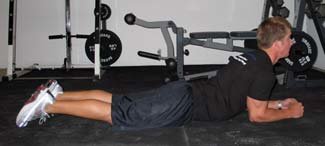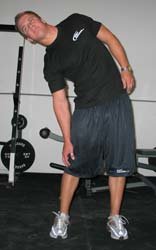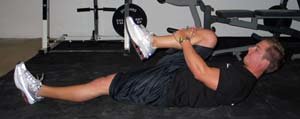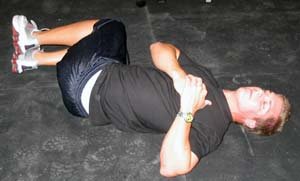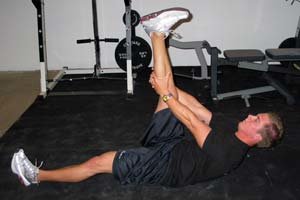To recuperate and grow to the fullest of ones potential, all aspects of health need to be addressed. Back and neck pain, and the problems underpinning this pain, will quickly hinder results if not prevented or addressed.
Typically, back and neck problems stem from an imbalance of a particular area of the spine. The spine (or vertebral column) has three natural curves (Lumber: lower back. Thoracic: mid back. Cervical: neck.), and weakness to any one of these curves will result in an imbalance which will more than likely have a flow on effect, weakening another part of the back.
For example, if the lower back (lumbar region) is injured, the neck (cervical region) will compensate for this and become imbalanced itself, and this will further exacerbate the original back problem. If the neck then becomes injured, or weakened, the pain will usually not go away because the area of primary injury which caused the imbalance will be unable to compensate for the new injury.
Muscle damage will need to be repaired otherwise there will be long term problems with pain and the imbalance will generally get worse. Therefore, prevention is very important. This article will primarily address back injury prevention for fitness enthusiasts. Personal experience has shown me that back pain can literally cripple ones efforts in the gym.
Main Causes Of Muscle Damage
Generally speaking there are two causes of back-related muscle damage. Direct injury, the most common cause, causes the muscle to tear. Over time the muscle will heal and scar tissue will develop causing the muscle to become shortened. Shortened muscles in the back will pull the bones attached to it out of position.
The second cause of muscle damage, and ultimately imbalance, results from excessive stress over a long period of time. The stress comes from improper use of the body, and imbalance in some other part of the body, or poor posture.
Spine Anatomy
To grasp an informed understanding of how spine injuries occur and why prevention is so important, a quick overview of the structure of the back is warranted; so bear with me for a minute.
The spinal cord is continuous with the brain and together they constitute the central nervous system (CNS). Bodily movement relies on the structure and function of the spinal cord and this warrants the protection of this most important of structures. The spine, which covers and protects the spinal cord, provides the body with stability and helps to coordinate movement.
In fact, the spine, along with the ribs and sternum, constitutes the skeleton of the trunk of the body. The spine itself is composed of a series of bones called vertebrae, of which the average spine has 26. The vertebrae are distributed in three curvatures of the spine, as mentioned earlier: The cervical (neck) region (7 vertebrae), the thoracic (mid back) region (12 vertebrae) and the lumbar (lower back) region (5 vertebrae). Below the lumbar region are 5 sacral vertebrae which are fused into one bone called the sacrum and 4 coccygeal vertebrae fused into two bones called the coccyx.
From the first cervical to the sacrum are intervertebral disks situated between adjacent vertebrae. The disks are very important because they absorb vertical shock, form strong joints and permit various movements of the vertebral column. Many back injuries result due to damage to the intervertebral disks.
In the average adult the spine measures about 71cm in length. The spine could be looked upon as a strong flexible rod that moves anteriorly, posteriorly and laterally, aiding movement in all directions. As mentioned, the spine encloses and protects the spinal cord. In addition to this it supports the head and serves as a point of attachment for the ribs and muscles of the back.
Postural Considerations
One of the biggest occupational health problems happens to be back and neck pain associated with sitting for long periods of time. Sitting in a slumped position will stretch the ligaments and muscles that extend the back. This weakens the back muscles over time.
Generally, when seated at the desk ensure that the back is flat against the chair and the feet are comfortably touching the ground. Discuss your specific requirements with an ergonomics specialist. When driving over long distances a similar problem arises. Always ensure that the car seat is adjusted to your specific requirements.
The most important, and easily corrected, preventable cause of back pain is posture. Posture essentially is the position one holds their body against gravity when walking sitting or lying. Correct posture prevents backache and muscular pain while keeping bones and joints in correct alignment so muscle are used properly.
Since one spends a great deal of their time walking and standing it is important to know exactly how to go about this:
- Hold head up straight with chin in and do not tilt head forward, sideways or backward.
- Earlobes should be in line with the middle of ones shoulders.
- Stretch the top of the head toward the ceiling.
- Keep knees and back straight and shoulders up.
- Tuck in stomach and do not tilt pelvis forward.
- Wear correct footwear to correctly support the arches of the feet.
Exercise For Optimal Back Health
Normal back function can, and should, be assisted through exercise if one is to prevent the aforementioned back problems. A general exercise program will help but specific combinations of exercises are recommended. Three different types of exercise should be considered: strengthening, flexibility and aerobic. Special recommendations follow:
Weight Training
To strengthen the supporting musculature surrounding the spine certain, specific, weight training exercises need to be considered. Total body development should be the focus of any weight training program, for complete balanced development.
However, the following exercises should be prioritized and never neglected if one wishes to strengthen protect their spine:
- Hyper-extensions (erector muscles of the lower back and hamstrings): 3 sets of 25-30. Weight can be held against chest when exercise becomes too easy.
- Good mornings (erectors, and hamstrings): a good substitute for hyper-extensions. However, lighter weights should be used.
- Squats (erector muscles, and complete leg development): 3 sets of 10 to 15.
- Deadlifts (complete back development): 3 sets of 8 to 12.
- Ab crunches and hanging leg raises (complete abbs and lower abbs respectively). 3 sets each of 25 to 30.
The above exercises will enhance core stability which is essential for strong, well balanced, spinal support.
A few years back I sustained a work-related lower back injury, which was worsened through playing rugby, and initially crippled my efforts in the gym. Most forms of intervention were used to correct this injury (a prolapsed disk in the lumber region), including acupuncture, physiotherapy, pain medication and rest. I was strongly advised to discontinue weight training.
However, pain persisted and I found myself back in the gym, trying to do something about it. The exercises mentioned here worked wonders for my particular injury and I have had no further back problems as a result of using them. I would, though, advise one to visit their physician to determine the type and extent of their injury before preceding with these injuries.
Stretching
In addition to weight training, stretching to increase flexibility is an essential spine protection method. Tissues around the spine and pelvis should be adequately flexible to allow normal spine movement. Being flexible in these areas prevents abnormal force on the joints and reduces injury potential.
Stretching should be done before, and after, every training session to prevent muscle strain and soreness and lessen the chance of injury. Stretches should be held for at least 10 seconds (preferably 15-20) with no bouncing or jerking. 3-4 sets for each stretch will be sufficient.
As with weight training, all regions of the body should be stretched, but to prevent spine injury, abdominal, lower back and hamstring areas should be prioritized. Recommended stretches follow:
Abs:
- Lie on stomach with elbows propping the body up until a stretch is felt throughout the ab region.
- Stand with feet shoulder width apart and slowly bend to one side until a stretch is felt. Repeat with the other side.
Lower Back:
- Lie on back with knees bent. Pull one knee to the chest at a time while keeping the opposite leg flat on the ground.
- Again, lie on back with knees bent. This time slowly drop both knees to one side until a stretch is felt.
Hamstrings:
- Lie with one leg flat on the floor and the other pointing toward the ceiling. Pull pointed leg back slowly until a stretch is felt.
- Stand with both feet flat against the ground. Bend at the waist and try to touch the ground with hands (this stretch also works the lower back). No bouncing.

Conclusion

The spine, and the muscles surrounding it, is, and are, arguably the most important part of the body to protect. It helps to conveys messages to the muscles, fulfilling its central nervous system function. It also plays a crucial role in providing stability for the rest of the body.
A spinal problem may spell disaster for the bodybuilder aiming to increase muscle size as it will create an imbalance and may limit strength in other areas. For this and the preceding reasons, importance should be placed on protecting the spine through the implementation of a correct weight and stretching program.
References
- Spine Universe.com.(2003). Posture for a healthy back; what is good posture. [Online]
- Bloomfield, J. Fricker, P.A. & Fitch, K.D.(1992). Textbook of Science and Medicine in Sport. Blackwell Scientific Publications. Australia.
- Marieb, E. & Mallatt, J.(2002). Human Anatomy (Third Ed). Benjamin/Cummings: USA.
The S.A.I.S. Mass-Building Routine!
Thanks,

